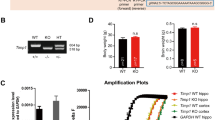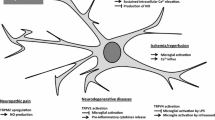Abstract
The transient receptor potential ankyrin 1 (TRPA1) channel is a non-selective cation channel that helps regulate inflammatory pain sensation and nociception and the development of inflammatory diseases. However, the potential role of the TRPA1 channel and the underlying mechanism in brain functions are not fully resolved. In this study, we demonstrated that genetic deletion of the TRPA1 channel in mice or pharmacological inhibition of its activity increased neurite outgrowth. In vivo study in mice provided evidence of the TRPA1 channel as a negative regulator in hippocampal functions; functional ablation of the TRPA1 channel in mice enhanced hippocampal functions, as evidenced by less anxiety-like behavior, and enhanced fear-related or spatial learning and memory, and novel location recognition as well as social interactions. However, the TRPA1 channel appears to be a prerequisite for motor function; functional loss of the TRPA1 channel in mice led to axonal bundle fragmentation, downregulation of myelin basic protein, and decreased mature oligodendrocyte population in the brain, for impaired motor function. The TRPA1 channel may play a crucial role in neuronal development and oligodendrocyte maturation and be a potential regulator in emotion, cognition, learning and memory, and social behavior.








Similar content being viewed by others
References
Fernandes ES, Fernandes MA, Keeble JE (2012) The functions of TRPA1 and TRPV1: moving away from sensory nerves. Br J Pharmacol 166(2):510–521
Koivisto A, Hukkanen M, Saarnilehto M, Chapman H, Kuokkanen K, Wei H, Viisanen H, Akerman KE et al (2012) Inhibiting TRPA1 ion channel reduces loss of cutaneous nerve fiber function in diabetic animals: sustained activation of the TRPA1 channel contributes to the pathogenesis of peripheral diabetic neuropathy. Pharmacol Res 65(1):149–158
García-Añoveros J, Nagata K (2007) TRPA1. Handb Exp Pharmacol 179:347–362
Birrell MA, Belvisi MG, Grace M, Sadofsky L, Faruqi S, Hele DJ, Maher SA, Freund-Michel V et al (2009) TRPA1 agonists evoke coughing in guinea pig and human volunteers. Am J Respir Crit Care Med 180(11):1042–1047
Caterina MJ (2007) Chemical biology: sticky spices. Nature 445(7127):491–492
Doihara H, Nozawa K, Kawabata-Shoda E, Kojima R, Yokoyama T, Ito H (2009) Molecular cloning and characterization of dog TRPA1 and AITC stimulate the gastrointestinal motility through TRPA1 in conscious dogs. Eur J Pharmacol 617(1–3):124–129
Earley S, Gonzales AL, Crnich R (2009) Endothelium-dependent cerebral artery dilation mediated by TRPA1 and Ca2 + −Activated K+ channels. Circ Res 104(8):987–994
El Andaloussi-Lilja J, Lundqvist J, Forsby A (2009) TRPV1 expression and activity during retinoic acid-induced neuronal differentiation. Neurochem Int 55(8):768–774
Louhivuori LM, Bart G, Larsson KP, Louhivuori V, Näsman J, Nordström T, Koivisto AP, Akerman KE (2009) Differentiation dependent expression of TRPA1 and TRPM8 channels in IMR-32 human neuroblastoma cells. J Cell Physiol 221(1):67–74
Ernsberger U (2009) Role of neurotrophin signalling in the differentiation of neurons from dorsal root ganglia and sympathetic ganglia. Cell Tissue Res 336(3):349–384
Wu D, Huang W, Richardson PM, Priestley JV, Liu M (2008) TRPC4 in rat dorsal root ganglion neurons is increased after nerve injury and is necessary for neurite outgrowth. J Biol Chem 283(1):416–426
Hjerling-Leffler J, Alqatari M, Ernfors P, Koltzenburg M (2007) Emergence of functional sensory subtypes as defined by transient receptor potential channel expression. J Neurosci 27(10):2435–2443
Jo KD, Lee KS, Lee WT, Hur MS, Kim HJ (2013) Expression of transient receptor potential channels in the ependymal cells of the developing rat brain. Anat Cell Biol 46(1):68–78
Shigetomi E, Jackson-Weaver O, Huckstepp RT, O’Dell TJ, Khakh BS (2013) TRPA1 channels are regulators of astrocyte basal calcium levels and long-term potentiation via constitutive D-serine release. J Neurosci 33(24):10143–10153
Clarke LE, Attwell D (2011) An astrocyte TRP switch for inhibition. Nat Neurosci 15(1):3–4
Shigetomi E, Tong X, Kwan KY, Corey DP, Khakh BS (2011) TRPA1 channels regulate astrocyte resting calcium and inhibitory synapse efficacy through GAT-3. Nat Neurosci 15(1):70–80
Coque L, Mukherjee S, Cao JL, Spencer S, Marvin M, Falcon E, Sidor MM, Birnbaum SG et al (2011) Specific role of VTA dopamine neuronal firing rates and morphology in the reversal of anxiety-related, but not depression-related behavior in the ClockΔ19 mouse model of mania. Neuropsychopharmacology 36(7):1478–1488
Lee PC, Dodart JC, Aron L, Finley LW, Bronson RT, Haigis MC, Yankner BA, Harper JW (2013) Altered social behavior and neuronal development in mice lacking the Uba6-Use1 ubiquitin transfer system. Mol Cell 50(2):172–184
Beutler LR, Eldred KC, Quintana A, Keene CD, Rose SE, Postupna N, Montine TJ, Palmiter RD (2011) Severely impaired learning and altered neuronal morphology in mice lacking NMDA receptors in medium spiny neurons. PLoS One 6(11), e28168
Paus T, Zijdenbos A, Worsley K, Collins DL, Blumenthal J, Giedd JN, Rapoport JL, Evans AC (1999) Structural maturation of neural pathways in children and adolescents: in vivo study. Science 283(5409):1908–1911
Kuhn PL, Petroulakis E, Zazanis GA, McKinnon RD (1995) Motor function analysis of myelin mutant mice using a rotarod. Int J Dev Neurosci 13(7):715–722
Sampaio-Baptista C, Khrapitchev AA, Foxley S, Schlagheck T, Scholz J, Jbabdi S, DeLuca GC, Miller KL et al (2013) Motor skill learning induces changes in white matter microstructure and myelination. J Neurosci 33(50):19499–19503
Schmithorst VJ, Wilke M, Dardzinski BJ, Holland SK (2005) Cognitive functions correlate with white matter architecture in a normal pediatric population: a diffusion tensor MRI study. Hum Brain Mapp 26(2):139–147
Yurgelun-Todd DA, Killgore WD, Young AD (2002) Sex differences in cerebral tissue volume and cognitive performance during adolescence. Psychol Rep 91(3 Pt 1):743–757
Casey BJ, Giedd JN, Thomas KM (2000) Structural and functional brain development and its relation to cognitive development. Biol Psychol 54(1–3):241–257
Rosenberg SS, Spitzer NC (2011) Calcium signaling in neuronal development. Cold Spring Harb Perspect Biol 3(10):a004259
Chattopadhyay N, Espinosa-Jeffrey A, Tfelt-Hansen J, Yano S, Bandyopadhyay S, Brown EM, de Vellis J (2008) Calcium receptor expression and function in oligodendrocyte commitment and lineage progression: potential impact on reduced myelin basic protein in CaR-null mice. J Neurosci Res 86(10):2159–2167
Pfeiffer SE, Warrington AE, Bansal R (1993) The oligodendrocyte and its many cellular processes. Trends Cell Biol 3(6):191–197
Takeda M, Nelson DJ, Soliven B (1995) Calcium signaling in cultured rat oligodendrocytes. Glia 14(3):225–236
Mato S, Victoria Sánchez-Gómez M, Matute C (2010) Cannabidiol induces intracellular calcium elevation and cytotoxicity in oligodendrocytes. Glia 58(14):1739–1747
Chattopadhyay N, Ye CP, Yamaguchi T, Kifor O, Vassilev PM, Nishimura R, Brown EM (1998) Extracellular calcium-sensing receptor in rat oligodendrocytes: expression and potential role in regulation of cellular proliferation and an outward K+ channel. Glia 24(4):449–458
Jamain S, Radyushkin K, Hammerschmidt K, Granon S, Boretius S, Varoqueaux F, Ramanantsoa N, Gallego J et al (2008) Reduced social interaction and ultrasonic communication in a mouse model of monogenic heritable autism. Proc Natl Acad Sci U S A 105(5):1710–1715
Leach JB, Brown XQ, Jacot JG, Dimilla PA, Wong JY (2007) Neurite outgrowth and branching of PC12 cells on very soft substrates sharply decreases below a threshold of substrate rigidity. J Neural Eng 4(2):26–34
Wang X, Wang Z, Yao Y, Li J, Zhang X, Li C, Cheng Y, Ding G, Liu L, Ding Z (1813) Essential role of ERK activation in neurite outgrowth induced by α-lipoic acid. Biochim Biophys Acta 5:827–838
Caceres A, Mautino J, Kosik KS (1992) Suppression of MAP2 in cultured cerebellar macroneurons inhibits minor neurite formation. Neuron 9(4):607–618
Wu PY, Lin YC, Chang CL, Lu HT, Chin CH, Hsu TT, Chu D, Sun SH (2009) Functional decreases in P2X7 receptors are associated with retinoic acid-induced neuronal differentiation of Neuro-2a neuroblastoma cells. Cell Signal 21(6):881–891
Story GM, Peier AM, Reeve AJ, Eid SR, Mosbacher J, Hricik TR, Earley TJ, Hergarden AC (2003) ANKTM1, a TRP-like channel expressed in nociceptive neurons, is activated b cold temperatures. Cell 112(6):819–829
Latorre R, Brauchi S, Orta G, Zaelzer C, Vargas G (2007) ThermoTRP channels as modular proteins with allosteric gating. Cell Calcium 42(4–5):427–438
Obata K, Katsura H, Mizushima T, Yamanaka H, Kobayashi K, Dai Y, Fukuoka T, Tokunaga A (2005) TRPA1 induced in sensory neuron contributes to cold hyperalgesia after inflammation and nerve injury. J Clin Invest 115(9):2393–2401
del Camino D, Murphy S, Heiry M, Barrett LB, Earley TJ, Cook CA, Petrus MJ, Zhao M (2010) TRPA1 contributes to cold hypersensitivity. J Neurosci 30(45):15165–15174
Chen J, Joshi SK, Di Domenico S, Perner RJ, Mikusa JP, Gauvin DM, Segreti JA, Han P (2011) Selective blockade of TRPA1 channel attenuates pathological pain without altering noxious cold sensation or body temperature regulation. Pain 152(5):1165–1172
de Moura JC, Noroes MM, Rachetti Vde P, Soares BL, Preti D, Nassini R, Materazzi S, Marone IM, Minocci D, Geppetti P, Gavioli EC, André E (2014) The blockade of transient receptor potential ankirin 1 (TRPA1) signalling mediates antidepressant- and anxiolytic-like actions in mice. Br J Pharmacol 171(18):4289–4299
Steinman L (2009) A molecular trio in relapse and remission in multiple sclerosis. Nat Rev Immunol 9(6):440–447
Wang GX, Poo MM (2005) Requirement of TRPC channels in netrin-1-induced chemotropic turning of nerve growth cones. Nature 434(7035):898–904
Hamilton NB, Kolodziejczyk K, Kougioumtzidou E, Attwell D (2016) Proton-gated Ca(2+)-permeable TRP channels damage myelin in conditions mimicking ischaemia. Nature 529(7587):523–527
Sofroniew MV, Vinters HV (2010) Astrocytes: biology and pathology. Acta Neuropathol 119(1):7–35
Sidoryk-Wegrzynowicz M, Wegrzynowicz M, Lee E, Bowman AB, Aschner M (2011) Role of astrocytes in brain function and disease. Toxicol Pathol 39(1):115–123
Borges K, McDermott D, Irier H, Smith Y, Dingledine R (2006) Degeneration and proliferation of astrocytes in the mouse dentate gyrus after pilocarpine-induced status epilepticus. Exp Neurol 201(2):416–427
Bambrick LL, Yarowsky PJ, Krueger BK (2003) Altered astrocyte calcium homeostasis and proliferation in theTs65Dn mouse, a model of Down syndrome. J Neurosci Res 73(1):89–94
Cornell-Bell AH, Finkbeiner SM, Cooper MS, Smith SJ (1990) Glutamate induces calcium waves in cultured astrocytes: long-range glial signaling. Science 247(4941):470–473
Morita M, Higuchi C, Moto T, Kozuka N, Susuki J, Itofusa R, Yamashita J, Kudo Y (2003) Dual regulation of calcium oscillation in astrocytes by growth factors and pro-inflammatory cytokines via the mitogen-activated protein kinase cascade. J Neurosci 23(34):10944–10952
Desai BN, Clapham DE (2005) TRP channels and mice deficient in TRP channels. Pflugers Arch 451(1):11–18
Riccio A, Li Y, Tsvetkov E, Gapon S, Yao GL, Smith KS, Engin E, Rudolph U, Bolshakov VY, Clapham DE (2014) Decreased anxiety-like behavior and Gαq/11-dependent responses in the amygdala of mice lacking TRPC4 channels. J Neurosci 34(10):3653–3667
Marsch R, Foeller E, Rammes G, Bunck M, Kössl M, Holsboer F, Zieglgänsberger W, Landgraf R, Lutz B, Wotjak CT (2007) Reduced anxiety, conditioned fear, and hippocampal long-term potentiation in transient receptor potential vanilloid type 1 receptor-deficient mice. J Neurosci 27(4):832–839
Ahmmed GU, Malik AB (2005) Functional role of TRPC channels in the regulation of endothelial permeability. Pflugers Arch 451(1):131–142
Hellwig N, Albrecht N, Harteneck C, Schultz G, Schaefer M (2005) Homo- and heteromeric assembly of TRPV channel subunits. J Cell Sci 118(Pt 5):917–928
Su KH, Lin SJ, Wei J, Lee KI, Zhao JF, Shyue SK, Lee TS (2014) The essential role of transient receptor potential vanilloid 1 in simvastatin-induced activation of endothelial nitric oxide synthase and angiogenesis. Acta Physiol (Oxf) 212(3):191–204
Acknowledgments
The authors thank Laura Smales for her help in language editing. This study was supported by grants from Ministry of Science and Technology (102-2628-B-010-001-MY3, 103-2628-B-010-040-MY3, 104-2811-B-010-020 and 104-2320-B-010-041-MY3), Yen Tjing Ling Medical Foundation (CI-104-10 and CI-104-13), and Ministry of Education, Aim for the Top University Plan, Taiwan.
Author information
Authors and Affiliations
Corresponding author
Ethics declarations
Competing Financial Interests
The authors declare that they have no competing interests.
Electronic supplementary material
Below is the link to the electronic supplementary material.
ESM 1
(PDF 575 kb)
Rights and permissions
About this article
Cite this article
Lee, KI., Lin, HC., Lee, HT. et al. Loss of Transient Receptor Potential Ankyrin 1 Channel Deregulates Emotion, Learning and Memory, Cognition, and Social Behavior in Mice. Mol Neurobiol 54, 3606–3617 (2017). https://doi.org/10.1007/s12035-016-9908-0
Received:
Accepted:
Published:
Issue Date:
DOI: https://doi.org/10.1007/s12035-016-9908-0




